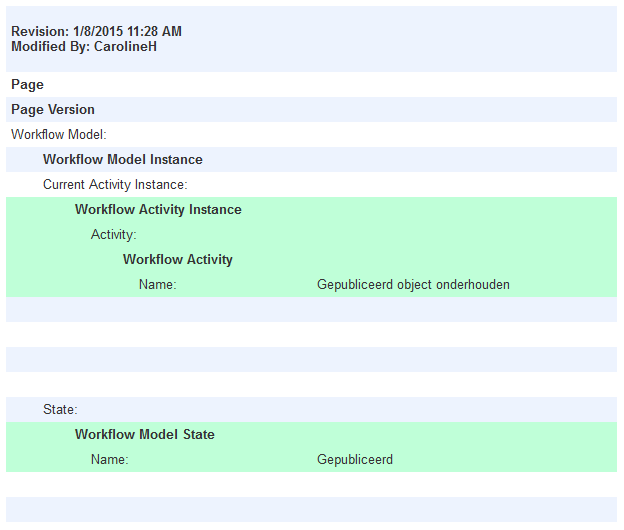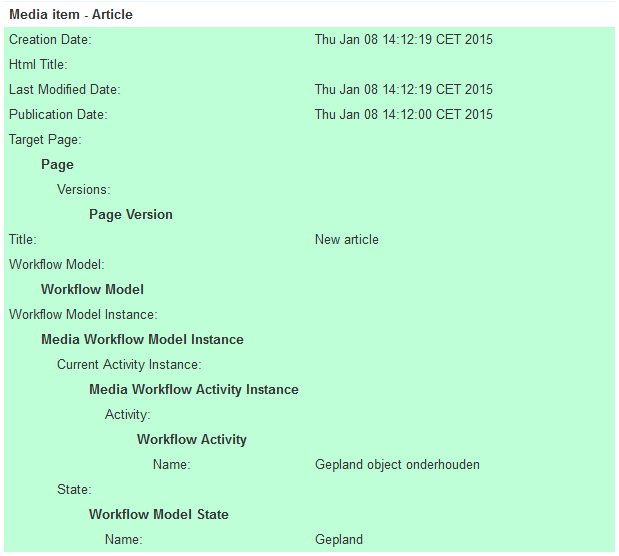| Anchor | ||||
|---|---|---|---|---|
|
...
- Navigate to the content item for which you want to view the audit trail to view it.
- Hover the mouse over the title of the content item, open the Actions menu and then select "Edit Properties".
- Click the "Status" tab.
- Click [View Audit Trail].
In This Topic
| Table of Contents | ||
|---|---|---|
|
...
Audit Trail Tab
On the Audit Trail tab, a record of all changes that have been made to pages, page sections, articles, and custom content items since they were created or since the last time the audit trail was purged can be viewed. For complete information on purging the audit trail, see Purging the Audit Trail.
...
- Language (see A below) — Select the language version of the page for which you want to view the audit trail. To view records for all available languages, select ‘All’.
- Page version (B) — Select the version of the page or page section for which you want to view the audit trail.
- From date (C) — Specify the start date of the period for which you want to view the audit trail records.
- To date (D) — Specify the end date of the period for which you want to view the audit trail records.
- Entries per page (E) — Select the number of audit trail entries you want to view per page. The options are 10, 25, or 50.
Once you have selected the filter parameters, click [Show]. The audit trail records that match the specified parameters will be shown. For example:
For each audit trail record, the following details are provided to describe the event:
...
| Column | Description |
|---|---|
| Create | Initial creation of the page, page section, article, or custom content item. |
| Update | The content has been updated. The following actions result in an update:
|
| Workflow update | The workflow state is modified. |
| Move | The page has been moved to a different location in the tree. |
| Duplicate | A duplicate has been made of a page, page section, or article. |
...
In the example above, the user "CarolineH" performed multiple actions within the period 1/8/2015 11:40 AM and 11:45 AM. The details of the multiple actions performed can be viewed by clicking the plus [+] next to "CarolineH" in order to expand the list. The result is a list detailing all actions of the same type that occurred during the session:
...
Changes Tab
On the Changes tab, all content that has been added, changed, and deleted can be viewed. For each revision, the date and time that the change occurred is listed together with the name of the user who performed the change. The default view always presents one revision of the page, page section, article, or custom content item compared with the revision that immediately precedes it.
You can navigate through each revision and see a direct comparison with the previous revision. For each revision, you have the option of viewing just the changes or the entire content, including that which has not changed. See the section ‘Comparing revisions’ for complete information on comparing two revisions with each other.
...
In the audit trail, the following details are shown for pages and page sections:
| Column | Description |
|---|---|
| Title | The title of the page or page section. |
| Navigation title | The navigation title of the page or page section. |
| Language | The language version of the page or page section. |
| Publication date | The date and time that the page or page section was created. |
| Expiration date | The date and time that the page or page section will expire. |
| Labels | Labels assigned to this page or page section. |
| Workflow model | The current workflow activity and state for the page or page section. |
For example:
Article Details
In the audit trail, the following details are shown for articles:
| Column | Description |
|---|---|
| Creation date | The date that the article was created. |
| Expiration date | The date that the article was created. |
| HTML title | The HTML title of the article. |
| Last modified date | The date on which the article was last modified. |
| Lead | The lead-in text for the article. |
| Publication date | Same as creation date. |
| Target page | The target page on which the article will be shown. |
| Terms | Terms assigned to this article. |
| Title | The title of the article. |
| Workflow model | The current workflow activity and state for the article. |
For example:
Element Details
In the audit trail, all details of elements are shown. The details are presented in a hierarchical structure that contains generic information that is then broken down into fine detail in outline fashion. Element details are shown under the "Elements" heading. The name of the element is shown in bold the next level in and then the specific details for the element appear indented below the element name. The audit trail record for each element type shows details specific to it. For information on a particular field, compare the audit trail record to the fields that appear in the element itself.
...
| Anchor | ||||
|---|---|---|---|---|
|
...
The following is an example of an expiration date added to a page:
...
| Anchor | ||||
|---|---|---|---|---|
|
...
When the text in a field or a detail for an element is removed, only the particular field that was removed is highlighted. In the following example, the expiration date for a page has been removed:
...
| Anchor | ||||
|---|---|---|---|---|
|
...
When the text in a rich text element is modified, the entire rich text element is shown as having been changed as opposed to individual bits of text. To determine what changed in the rich text element, compare it side by side immediate revision prior to it. See the following section for complete information on performing side by side comparisons of content item revisions.
...
Comparing Revisions
The color coding denoting added, removed, and changed content makes it easy to quickly interpret how content has been changed between two revisions. Because two revisions are always shown side by side, you can not only clearly see the changes that have been made but also the previous state of the part of the content item that has been changed.
By selecting the view ‘Changes only’ you can see summary of only the changes that occurred between two revisions instead of the complete content of the item. For pages, page sections, articles, and custom content items containing a lot of content, this makes it easier to locate the changes.
To navigate between revisions, click [Next revision] or [Previous revision]. In this way you can step through the entire audit trail history of the content item:
...
- Workflow activity "Maintained published object" has been deleted.
- Workflow model state Published has been deleted.
- Workflow activity "Maintain planned object" has been added.
- Workflow model state Planned has been added.
...
Deleted Items Tab
On the Deleted Items tab you can see all content objects/items that have been deleted since the initial creation of the website or since the last time the audit trail was purged. While the objects themselves cannot be restored once deleted, you can view the audit trail of deleted content items/objects (pages, page sections, articles, and custom content items). For complete information on purging the audit trail, see the section Purging the Audit Trail.
For each content type (page, page section, article or custom content item), the following information is provided:
| Column | Description |
|---|---|
| Title | The title of the deleted item (not the navigation, HTML, or URL title). |
| Content type | The content type of the deleted item (page, page section, article, or custom content item). |
| Date and time of deletion | The local date and time when the item was deleted. |
| Username | The name of the user who deleted the item. |
| ID | The unique identifier of the deleted item. |
| Original path | The original path of the deleted item. For pages and page sections, the parent hierarchy in the page/page section tree is shown. For articles and custom content items, the original path is always ‘Media repository’. Pages deleted from the ‘Orphan pages’ tree do not include a parent page hierarchy. |
| Audit trail | A link that allows you to view the audit trail of the deleted item. |
...
You can also sort deleted items in ascending or descending numerical order according to the column headings. To change the sort order, click the column heading of the parameter by which you want to sort the deleted items. The current sort order is identified by the dark blue triangle that appears to the right of the column header by which the deleted items are currently sorted. The down facing arrow indicates that the sort order is currently descending alphabetical or numerical order. The up facing arrow indicates that the sort order is currently ascending alphabetical or numerical order
...
| Anchor | ||||
|---|---|---|---|---|
|
Using the Audit Trail tab of the XperienCentral Setup Tool, you can purge the audit trail for existing and deleted pages, page sections, articles, and custom content items. You can purge all audit trail information completely or tracked changes up to and including a specific date.
| Warning |
|---|
|
...
For complete information on purging information from the audit trail, see Audit Trail.







